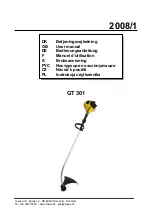
ENVIRONMENTALLy SAfE bATTERy DISPOSAL
11
EN
WARNING
All toxic materials must be disposed of in a
specified manner to prevent contamination of the
environment. Before disposing of damaged or worn
out Lithium-Ion battery packs, contact your local
waste disposal agency, or the local Environmental
Protection Agency for information and specific
instructions. Take the batteries to a local recycling
and/or disposal center, certified for lithium-ion
disposal
WARNING
If the battery pack cracks or breaks, with or without
leaks, do not recharge it and do not use. Dis pose of
it and replace with a new battery pack.
DO NOT ATTEMPT TO REPAIR IT!
To avoid injury and risk of fire, explosion, or electric
shock, and to avoid damage to the environment:
·Cover the battery’s terminals with heavy-duty
adhesive tape
·
DO NOT
attempt to remove or destroy any of the
battery pack components.
·
DO NOT
attempt to open the battery pack.
·If a leak develops, the released electrolytes are
corrosive and toxic. D
O NOT
get the solution in the
eyes or on skin, and do not swallow it.
·
DO NOT
place these batteries in your regular
household trash.
·
DO NOT
incinerate.
·
DO NOT
place them where they will become part of
any waste landfill or municipal solid waste stream.
Take them to a certified recycling or disposal center.
MAINTENANCE
WARNING
To avoid risk of fire, electric shock, or
electrocution:
–
Do not use a damp cloth or detergent on the
battery or battery charger.
–
Always remove the battery pack before
cleaning, inspecting, or performing any
maintenance on the hedge trimmer.
Cleaning
1. Wipe the outside of the hedge trimmer with a dry,
soft cloth. Do not hose down or wash with water.
2. Scrape the guard to remove dried clippings and
mud.
3. Brush or blow dust, debris, and grass clippings out
of the air vents. Keep them free of obstruction.












































